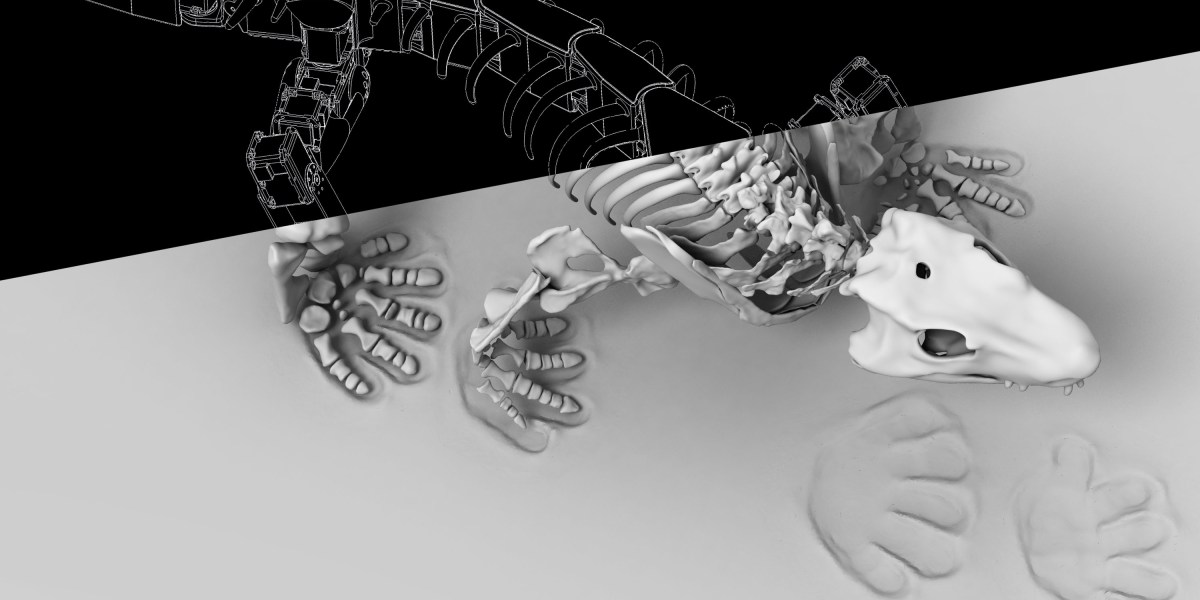Paleontologists aren’t simply deterred by evolutionary lifeless ends or a sparse fossil report. However in the previous few years, they’ve developed a brand new trick for turning again time and learning prehistoric animals: constructing experimental robotic fashions of them. Within the absence of a dwelling specimen, scientists say, an ambling, flying, swimming, or slithering automaton is the subsequent smartest thing for learning the conduct of extinct organisms. Studying extra about how they moved can in flip make clear points of their lives, similar to their historic ranges and feeding habits.
Digital fashions already do an honest job of predicting animal biomechanics, however modeling complicated environments like uneven surfaces, unfastened terrain, and turbulent water is difficult. With a robotic, scientists can merely sit again and watch its conduct in numerous environments. “We are able to take a look at its efficiency with out having to think about each element, [as] within the simulation,” says John Nyakatura, an evolutionary biologist at Humboldt College in Berlin.
The union of paleontology and robots has its roots within the extra established subject of bio-inspired robotics, by which scientists trend robots primarily based on fashionable animals. Paleo-roboticists, nonetheless, face the added complication of designing robotic programs for which there isn’t any dwelling reference. They work round this limitation by abstracting from the subsequent most suitable choice, similar to a contemporary descendant or an incomplete fossil report. To assist ensure that they’re heading in the right direction, they could attempt to derive normal options from fashionable fauna that radiated from a standard ancestor on the evolutionary tree. Or they could flip to good ol’ physics to house in on essentially the most believable methods an animal moved. Biology may need modified over hundreds of thousands of years; the basic legal guidelines of nature, not a lot.
Trendy technological advances are pulling paleo-inspired robotics right into a golden age. Pc-aided design and leading-edge fabrication methods similar to 3D printing permit researchers to quickly churn out prototypes. New supplies develop the avenues for movement management in an automaton. And improved 3D imaging know-how has enabled researchers to digitize fossils with unprecedented element.
All this helps paleo-roboticists spin up extra reasonable robots—ones that may higher attain the fluid movement related to dwelling, respiration animals, versus the stilted actions seen in older generations of robots. Now, researchers are transferring nearer to learning the sorts of behavioral questions that may be investigated solely by bringing extinct animals again to life—or one thing prefer it. “We actually assume that that is such an underexplored space for robotics to actually contribute to science,” says Michael Ishida, a roboticist at Cambridge College within the UK who penned a evaluate research on the sphere.
Listed below are 4 examples of robots which can be shedding mild on creatures of yore.
The OroBot
Within the late 2010s, John Nyakatura was working to check the gait of an extinct creature known as Orobates pabsti. The four-limbed animal, which prowled Earth 280 million years in the past, is basically a thriller—it dates to a time earlier than mammals and reptiles developed and was in truth associated to the final frequent ancestor of the 2 teams. A breakthrough got here when Nyakatura met a roboticist who had constructed an automaton that was impressed by a contemporary tetrapod—a salamander. The connection began the way in which many serendipitous collaborations do: “We simply talked over beer,” Nyakatura says. The crew tailored the prevailing robotic blueprint, with the paleontologists feeding the anatomical specs of the fossil to the roboticists to construct on. The researchers christened their brainchild OroBot.


OroBot’s proportions are knowledgeable by CT scans of fossils. The researchers used off-the-shelf components to assemble the automaton. The big sizes of normal actuators, gadgets that convert vitality into movement, meant they needed to scale up OroBot to about one and a half yards (1.4 meters) in size, twice the scale of the unique. In addition they outfitted the bot with versatile pads for tread as a substitute of anatomically correct toes. Ft are complicated bodily buildings which can be a nightmare to copy: They’ve a variety of movement and many connective comfortable tissue.

Due to the crew’s artistic shortcut, OroBot seems as if it’s tromping in flip-flops. However the robotic’s designers took pains to get different particulars simply so, together with its 3D-printed fake bones, which have been painted a ruddy coloration and given an osseous texture to extra intently mimic the unique fossil. It was a scientifically pointless design selection, however a labor of affection. “You possibly can inform that the engineers actually favored this robotic,” Nyakatura stated. “They actually fell in love with it.”
As soon as OroBot was full, Nyakatura’s crew put it on a treadmill to see the way it walked. After measuring the robotic’s vitality consumption, its stability in movement, and the similarity of its tracks to fossilized footprints, the researchers concluded that Orobates in all probability sashayed like a contemporary caiman, the considerably punier cousin of the crocodile. “We predict we discovered proof for this extra superior terrestrial locomotion, some 50 million years sooner than beforehand anticipated,” Nyakatura says. “This adjustments our idea of how early tetrapod evolution passed off.”
Robotic ammonites
Ammonites have been shell-toting cephalopods—the animal class that encompasses fashionable squids and octopuses—that lived through the age of the dinosaurs. The one surviving ammonite lineage in the present day is the nautilus. Fossils of ammonites, although, are considerable, which suggests there are many good references for researchers excited by learning their shells—and constructing robotic fashions.

ammonite shell lower in half.
When David Peterman, an evolutionary biomechanist, was a postdoctoral fellow on the College of Utah from 2020 to 2022, he wished to check how the buildings of various ammonite shells influenced the underwater motion of their house owners. Extra merely put, he wished to substantiate “whether or not or not [the ammonites] have been able to swimming,” he says. From the fossils alone, it’s not obvious how these ammonites fared in aquatic environments—whether or not they wobbled uncontrolled, moved sluggishly, or zipped round with ease. Peterman wanted to construct a robotic to search out out.

It’s simple to repeat the shell dimension and form from the fossils, however the true check comes when the robotic hits the water. Mass distribution is every little thing; an unbalanced creature will flop and bob round. To keep away from that downside, Peterman added inside counterweights to compensate for a battery right here or the jet thruster there. On the similar time, he needed to account for the full mass to realize impartial buoyancy, in order that within the water the robotic neither floated nor sank.

Then got here the enjoyable half—robots of various shell sizes ran drag races within the college’s Olympic-sized swimming pool, drawing the curiosity of different gym-goers. What Peterman discovered was that the shells needed to strike a tough stability of stability and maneuverability. There was nobody finest construction, the crew concluded. Narrower shells have been stabler and will slice via the water whereas staying upright. Conches that have been wider have been nimbler, however ammonites would wish extra vitality to keep up their verticality. The shell an historical ammonite adopted was the one which suited or finally formed its specific life-style and swimming kind.

Robofish
What if roboticists haven’t any fossil reference? This was the conundrum confronted by Michael Ishida’s crew, who wished to higher perceive how historical marine animals first moved from sea to land almost 400 million years in the past and realized to stroll.
Missing transitional fossils, the researchers appeared to fashionable ambulatory fishes. A complete number of gaits are on show amongst these scaly strollers—the four-finned crawl of the epaulette shark, the terrestrial butterfly stroke of a mudskipper. Just like the converging roads in Rome, a number of historical fishes had independently arrived at alternative ways of strolling. Ishida’s group determined to concentrate on one specific gait: the half step, half slither of the bichir Polypterus senegalus.
Admittedly, the crew’s “robofish” seems nothing just like the still-extant bichir. The physique consists of inflexible segments as a substitute of a comfortable, versatile polymer. It’s a drastically watered-down model, as a result of the crew is attempting to find the minimal set of options and actions which may permit a fishlike creature to push ahead with its appendages. “‘Minimal’ is a tough phrase,” Ishida says. However robotic experiments will help rule out the bodily implausible: “We are able to at the least have some proof to say, sure, with this specific bone construction, or with this specific joint morphology, [a fish] was in all probability in a position to stroll on land.” Beginning with the construct of a contemporary fish, the crew simplified the robotic additional and additional till it may now not sally forth. It was the equal of working backwards within the evolutionary timeline.
The crew hopes to publish its ends in a journal someday quickly. Even within the rush to finalize the manuscript, Ishida nonetheless acknowledges how lucky he’s to be doing one thing that’s concurrently futuristic and prehistoric. “It’s each child’s dream to construct robots and to check dinosaurs,” he says. Day-after-day, he will get to do each.
The Rhombot
Practically 450 million years in the past, an echinoderm with the construct of an oversize sperm lumbered throughout the seafloor. The lineage of that creature, the pleurocystitid, has lengthy since been snuffed out, however proof of its existence lies frozen amongst quite a few fossils. The way it moved, although, is anybody’s guess, for no modern-day animal resembles this bulbous critter.

Carmel Majidi, a mechanical engineer at Carnegie Mellon College, was already constructing robots within the likeness of starfish and different modern-day echinoderms. Then his crew determined to use the identical expertise to check their pleurocystitid predecessor to untangle the thriller of its motion.

Majidi’s crew borrowed a trick from earlier efforts to construct comfortable robots. “The primary problem for us was to include actuation within the organism,” he says. The stem, or tail, wanted to be pliable but go inflexible on command, like precise muscle. Embedding premade motors, that are normally made from stiff materials, within the tail wouldn’t work. Ultimately, Majidi’s crew original the appendage out of shape-memory alloy, a type of metallic that deforms or retains its form, relying on the temperature. By delivering localized heating alongside the tail via electrical stimulation, the scientists may get it to bend and flick.

Each Majidi’s ensuing Rhombot and pc simulations, printed in 2023, confirmed that pleurocystitids seemingly beat their tails back and forth in a sweeping trend to propel themselves ahead, and their speeds trusted the tail stiffness and physique angle. The crew discovered that having an extended stem—as much as two-thirds of a foot lengthy—was advantageous, including pace with out incurring larger vitality prices. Certainly, the fossil report confirms this evolutionary development. Sooner or later, the researchers plan to check out Rhombot on much more floor textures, similar to muddy terrain.
Shi En Kim is a contract science author primarily based in Washington, DC.



